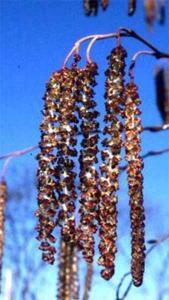Alnus Spaethii Spaeth's Alder
1. Add items to basket
2. Go to the basket
3. Enter your postcode in Delivery Price Check
Plant shape: Full standard
Trunk height: 1.6-1.8 m
Trunk girth: 8-10 cm
Rootball - supplied without a pot
Plant ID: 4054 100
Plant shape: Full standard
Trunk height: 1.8 m
Trunk girth: 12-14 cm
Rootball - supplied without a pot
Plant ID: 4055 100
View plant size:Plant shape: Full standard
Trunk height: 2 m
Trunk girth: 14-16 cm
Rootball - supplied without a pot
Plant ID: 4056 100
To check delivery cost add your plants to basket, then you can type your postcode in our Quick Delivery Price Check.
Alnus Spaethii, also called the Spaeth’s Alder is an alder hybrid cross between Japanese alder (Alnus japonica) and the Caucasian alder (Alnus subcordata). This is a fast-growing small deciduous tree and usually attains a height of 10 to 15 meters. The stem of the tree is exceptionally straight and the overall growth habit is narrow. When young, Spaeth’s Alder branches grow straight upward but as it matures, the branches bend to a horizontal angle. This makes the tree an ideal street tree or specimen tree for any landscape that requires a slender columnar tree.
Spaeth’s Alder more resembles a cherry tree in appearance than an alder. Often as early as January, Alnus Spaethii starts to develop dangling yellow catkins. Each catkin measures approximately 10 centimetres in length and is a valuable early season food source for hungry bees. The catkins usually persist on the tree into March before they give way to large, ovate leaves that are purplish when young. Upon maturity, the leaves develop into a dark green hue. The underside is a matte green and the topside a glossy green. Each serrated leaf measures 15 centimetres. In the autumn months, the foliage turns a dark orange or red before falling from the tree.
A hardy tree, Alnus Spaethii thrives in all soil types. As with many alder trees, the root system has the unique ability to fix nitrogen into the surrounding soil which allows the tree to grow in nutrient-poor locations. It can even thrive in sandy soil where many plants and trees fail.
Best growth is attained in moist soil, but once mature the tree can withstand short periods of drought. Its affinity for wet soil makes it ideal to plant in flood-prone locations. The tree is salt tolerant and can to tolerate windy conditions which makes it a good choice for coastal regions. Plant Spaeth’s Alder in a sunny or partially sunny location for optimum growth and flower development.
Spaeth’s Alder was first discovered by the botanist Ludwig Späth in the Späth Arboretum at the Späth Baumschule (Arboretum) in Berlin. It rapidly became a valuable landscape tree across most of Europe and it makes a beautiful avenue or street tree. Although it is still rare in the United States, it is gaining some popularity as more gardeners discover its landscape benefits.












